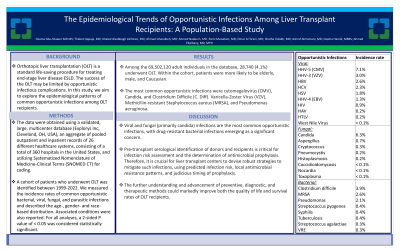Tuesday Poster Session
Category: Liver
P3806 - The Epidemiological Trends of Opportunistic Infections Among Liver Transplant Recipients: A Population-Based Study
Tuesday, October 24, 2023
10:30 AM - 4:00 PM PT
Location: Exhibit Hall

Has Audio
- OA
Osama Abu-Shawer, MD, MS
Cleveland Clinic
Cleveland, OH
Presenting Author(s)
Osama Abu-Shawer, MD, MS1, Thabet Qapaja, MD1, Khaled Alsabbagh Alchirazi, MD1, Ahmad Gharaibeh, MD1, Ahmed Nadeem, MD1, Rami Musallam, MD2, Omar Al Ta’ani, MD3, Shatha Tailakh, MD4, Ashraf Almomani, MD5, Osama Hamid, MBBS1, Ahmed Eltelbany, MD, MPH1
1Cleveland Clinic, Cleveland, OH; 2Case Western Reserve University School of Medicine, Cleveland, OH; 3Allegheny General Hospital, Pittsburgh, PA; 4University of Jordan, Amman, 'Amman, Jordan; 5Cleveland Clinic Florida, Weston, FL
Introduction: Orthotopic liver transplantation (OLT) is a standard life-saving procedure for treating end-stage liver disease ESLD. The success of the OLT may be limited by opportunistic infectious complications. In this study, we aim to explore the epidemiological patterns of common opportunistic infections among OLT recipients.
Methods: The data were obtained using a validated, large, multicenter database (Explorys Inc, Cleveland, OH, USA), an aggregate of pooled outpatient and inpatient records of 26 different healthcare systems, consisting of a total of 360 hospitals in the United States, and utilizing Systematized Nomenclature of Medicine-Clinical Terms (SNOMED CT) for coding. A cohort of patients who underwent OLT was identified between 1999-2022. We measured the incidence rates of common opportunistic bacterial, viral, fungal, and parasitic infections and described the age-, gender- and race-based distribution. Associated conditions were also reported. For all analyses, a 2-sided P value of < 0.05 was considered statistically significant.
Results: Among the 69,502,120 adult individuals in the database, 28,740 (4.1%) underwent OLT. Within the cohort, patients were more likely to be elderly, male, and Caucasian, table-1. The most common opportunistic infections were cytomegalovirus (CMV), Candida, and Clostridium Difficile (C. Diff). Varicella-Zoster Virus (VZV), Methicillin-resistant Staphylococcus aureus (MRSA), and Pseudomonas aeruginosa, table-2.
Discussion: Viral and fungal (primarily candida) infections are the most common opportunistic infections, with drug-resistant bacterial infections emerging as a significant concern. Pre-transplant serological identification of donors and recipients is critical for infection risk assessment and the determination of antimicrobial prophylaxis. Therefore, it is crucial for liver transplant centers to devise robust strategies to mitigate such infections, using predicted infection risk, local antimicrobial resistance patterns, and judicious timing of prophylaxis. The further understanding and advancement of preventive, diagnostic, and therapeutic methods could markedly improve both the quality of life and survival rates of OLT recipients.
Disclosures:
Osama Abu-Shawer, MD, MS1, Thabet Qapaja, MD1, Khaled Alsabbagh Alchirazi, MD1, Ahmad Gharaibeh, MD1, Ahmed Nadeem, MD1, Rami Musallam, MD2, Omar Al Ta’ani, MD3, Shatha Tailakh, MD4, Ashraf Almomani, MD5, Osama Hamid, MBBS1, Ahmed Eltelbany, MD, MPH1. P3806 - The Epidemiological Trends of Opportunistic Infections Among Liver Transplant Recipients: A Population-Based Study, ACG 2023 Annual Scientific Meeting Abstracts. Vancouver, BC, Canada: American College of Gastroenterology.
1Cleveland Clinic, Cleveland, OH; 2Case Western Reserve University School of Medicine, Cleveland, OH; 3Allegheny General Hospital, Pittsburgh, PA; 4University of Jordan, Amman, 'Amman, Jordan; 5Cleveland Clinic Florida, Weston, FL
Introduction: Orthotopic liver transplantation (OLT) is a standard life-saving procedure for treating end-stage liver disease ESLD. The success of the OLT may be limited by opportunistic infectious complications. In this study, we aim to explore the epidemiological patterns of common opportunistic infections among OLT recipients.
Methods: The data were obtained using a validated, large, multicenter database (Explorys Inc, Cleveland, OH, USA), an aggregate of pooled outpatient and inpatient records of 26 different healthcare systems, consisting of a total of 360 hospitals in the United States, and utilizing Systematized Nomenclature of Medicine-Clinical Terms (SNOMED CT) for coding. A cohort of patients who underwent OLT was identified between 1999-2022. We measured the incidence rates of common opportunistic bacterial, viral, fungal, and parasitic infections and described the age-, gender- and race-based distribution. Associated conditions were also reported. For all analyses, a 2-sided P value of < 0.05 was considered statistically significant.
Results: Among the 69,502,120 adult individuals in the database, 28,740 (4.1%) underwent OLT. Within the cohort, patients were more likely to be elderly, male, and Caucasian, table-1. The most common opportunistic infections were cytomegalovirus (CMV), Candida, and Clostridium Difficile (C. Diff). Varicella-Zoster Virus (VZV), Methicillin-resistant Staphylococcus aureus (MRSA), and Pseudomonas aeruginosa, table-2.
Discussion: Viral and fungal (primarily candida) infections are the most common opportunistic infections, with drug-resistant bacterial infections emerging as a significant concern. Pre-transplant serological identification of donors and recipients is critical for infection risk assessment and the determination of antimicrobial prophylaxis. Therefore, it is crucial for liver transplant centers to devise robust strategies to mitigate such infections, using predicted infection risk, local antimicrobial resistance patterns, and judicious timing of prophylaxis. The further understanding and advancement of preventive, diagnostic, and therapeutic methods could markedly improve both the quality of life and survival rates of OLT recipients.
Disclosures:
Osama Abu-Shawer indicated no relevant financial relationships.
Thabet Qapaja indicated no relevant financial relationships.
Khaled Alsabbagh Alchirazi indicated no relevant financial relationships.
Ahmad Gharaibeh indicated no relevant financial relationships.
Ahmed Nadeem indicated no relevant financial relationships.
Rami Musallam indicated no relevant financial relationships.
Omar Al Ta’ani indicated no relevant financial relationships.
Shatha Tailakh indicated no relevant financial relationships.
Ashraf Almomani indicated no relevant financial relationships.
Osama Hamid indicated no relevant financial relationships.
Ahmed Eltelbany indicated no relevant financial relationships.
Osama Abu-Shawer, MD, MS1, Thabet Qapaja, MD1, Khaled Alsabbagh Alchirazi, MD1, Ahmad Gharaibeh, MD1, Ahmed Nadeem, MD1, Rami Musallam, MD2, Omar Al Ta’ani, MD3, Shatha Tailakh, MD4, Ashraf Almomani, MD5, Osama Hamid, MBBS1, Ahmed Eltelbany, MD, MPH1. P3806 - The Epidemiological Trends of Opportunistic Infections Among Liver Transplant Recipients: A Population-Based Study, ACG 2023 Annual Scientific Meeting Abstracts. Vancouver, BC, Canada: American College of Gastroenterology.
